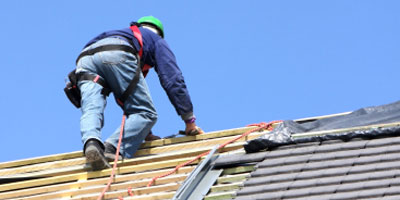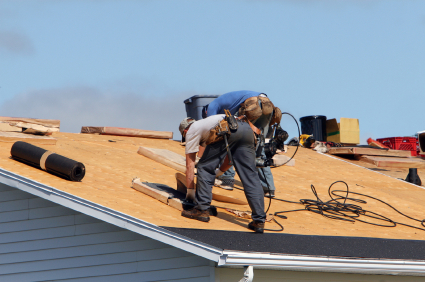How a Roofing Company Near Me Can Help You Customize Your Home’s Look
Exactly How Weather Can Effect Your Roofing Durability
Your roofing system deals with consistent difficulties from the weather, and it's critical to understand exactly how these problems can shorten its life expectancy. Each component plays a duty in your roofing system's longevity, yet just how can you efficiently prepare for these hazards?
The Results of UV Rays on Roof Products
Although you might not think of it often, UV rays can substantially impact the life expectancy of your roof products. When your roofing is subjected to sunlight, those unsafe rays can cause significant damages gradually. For example, UV radiation breaks down the chemical bonds in products like asphalt tiles, bring about breaking, fading, and wear and tear. This destruction deteriorates your roofing system and makes it much less effective at safeguarding your home (Roofer Novi).
You can alleviate these results by selecting UV-resistant roofing materials or using safety finishings. Regular inspections additionally aid catch very early indicators of damage, enabling you to deal with concerns prior to they rise. Furthermore, take into consideration setting up reflective roof covering options that can deflect UV rays and maintain your home colder. By staying aggressive about UV exposure, you'll prolong the life of your roofing and enhance your home's general sturdiness. Taking these actions currently can save you money and stress and anxiety in the future.
Just How Excessive Rainfall Can Result In Roof Damage
While UV rays can damage your roofing, extreme rains postures an additional substantial hazard to its stability. When hefty rainfalls happen, water can pool on your roofing system, leading to prospective leaks and structural damage gradually. If your roof covering products aren't made to handle long term exposure to dampness, they can wear away faster than anticipated.
Blocked rain gutters can worsen these problems, creating water to overflow and seep into your home. You may see stains on your ceilings or walls, signaling that water is locating its method inside. Additionally, standing water can advertise mold development, which not just harms your roof covering however can likewise influence your interior air top quality.
To shield your roof covering, verify your drainage systems are clear and operating correctly. Normal examinations can help you recognize vulnerable points before they become pricey repairs, maintaining your roofing system healthy also during hefty rains.
The Impact of Snow and Ice Build-up
When snow and ice stack up on your roofing, you may not realize the stress and anxiety it places on the framework. That included weight can lead to significant problems like roof covering drooping and even collapse. And also, ice dam development can trap water, creating leakages and further damages to your home.
Snow Tons Stress And Anxiety
As winter coverings your home in snow, the weight of gathered ice and snow can put significant stress and anxiety on your roof covering. When snow develops up, it can go beyond the load-bearing capacity of your roof covering materials, resulting in prospective sagging or also collapse. You could not understand exactly how quickly snow can build up, specifically throughout hefty storms, so it's crucial to keep an eye on the weight your roofing system is sustaining. Consistently getting rid of snow can help minimize this stress, reducing the threat of long-lasting damage. In addition, comprehending your roofing system's structure and its snow lots rating can notify you about when to act. Remember, prevention is vital to maintaining your roofing's integrity and long life during the winter months.
Ice Dam Development
Ice dam development can become a considerable concern throughout wintertime, particularly when snow collects on your roof covering and temperatures rise and fall. When warm runs away from your home, it melts the snow on your roof covering, creating water to stream down. As this water reaches the cooler eaves, it freezes, creating a dam that prevents further drain. Gradually, this trapped water can permeate under shingles, resulting in leaks and considerable damage to your roof covering framework. To stop ice dams, see to it your attic is correctly protected and aerated. You need to likewise consistently remove snow accumulation from your roof. By taking these precautions, you'll assist expand your roofing's lifespan and prevent costly repair services triggered by ice dam issues.
Temperature Fluctuations and Their Role in Roof Covering Wear And Tear
Temperature fluctuations can seriously affect your roof covering's life-span. As products expand and agreement with warm and cold, they end up being extra vulnerable to cracks and damages. Furthermore, freeze-thaw cycles can intensify these problems, causing further damage in time.
Thermal Expansion Effects
When temperatures rise and fall, your roofing can undertake significant thermal growth and contraction, which may cause material anxiety and degeneration in time. As the sun heats your roof throughout the day, products increase; when temperatures drop in the evening, they contract. This consistent cycle can create weak points, specifically at joints and joints. You could notice splits, bending, or loosened roof shingles because of this. These problems can lead to leaks and costly fixings if left uncontrolled. To alleviate damage, consider making use of roof materials developed to hold up against these temperature adjustments. Regular examinations can additionally help you catch early indicators of wear, ensuring your roof remains resilient and effective in safeguarding your home.
Freeze-Thaw Cycles
As winter season embed in, the freeze-thaw cycles can wreak chaos on your roof. Moisture from rainfall or snow leaks into cracks and holes when temperatures dip. As it freezes, it broadens, putting tremendous pressure on your roof materials. This cycle repeats as temperatures fluctuate, slowly causing wear and tear. You may Siding Contractor observe shingles splitting, crinkling, or perhaps damaging apart over time.
Disregarding these issues can result in even more considerable troubles, consisting of leakages and architectural damage. To protect your roofing system, it's necessary to examine it frequently, especially after severe weather. Resolving minor issues quickly can aid prolong the life of your roof, ensuring it stands up to the harsh results of freeze-thaw cycles throughout wintertime.
Moisture Degrees and Their Effect on Roofing System Integrity
While lots of people focus on temperature level fluctuations, humidity degrees play a critical role in figuring out the honesty of your roof. High humidity can produce a damp setting that motivates mold and mildew, algae, and mold development, every one of which can damage roofing products over time. If your roofing's ventilation isn't ample, wetness can get caught, leading to timber rot and other structural problems.
Alternatively, low moisture can cause dry conditions, causing materials like roof shingles to become brittle and crack. This brittleness can make them more susceptible to harm from other weather condition aspects.
To keep your roof covering's integrity, it is very important to keep track of moisture levels and assure correct air flow. Routine examinations and upkeep can aid determine prospective problems prior to they end up being significant problems. Maintaining your roof covering in excellent condition indicates being positive concerning humidity results, ultimately extending its life expectancy and securing your home.
Wind Damages: A Quiet Risk to Your Roofing System
Humidity isn't the only climate factor to consider; wind damages can quietly endanger your roof covering's integrity. Strong winds can lift roof shingles, loosen up flashing, and also detach entire sections of your roof. You could not observe these issues immediately, but gradually, they can bring about considerable leaks and structural damages.
If you live in an area vulnerable to high winds, it's important to watch on your roof after storms. Inspect for any type of missing out on or damaged roof shingles and examine the edges where the roof covering satisfies other surface areas. Siding Contractor. Pay attention to any kind of debris that might have collected, as this can catch moisture and aggravate damage
Ignoring these indicators might save you time now, however it can cost you more in the lengthy run. A positive technique to wind damage can assist guarantee your roofing system stays protected and strong, prolonging its lifespan and securing your home.
Preparing Your Roofing System for Extreme Weather Condition Events
When preparing your roofing system for severe weather condition occasions, it's essential to evaluate its present condition and make required upgrades. Begin by evaluating for missing or damaged tiles, as these can cause leakages during navigate to these guys heavy rain or snow. Replace any endangered materials to ensure a strong structure.
Next, examine the flashing around skylights, chimneys, and vents. Appropriately secured blinking avoids water from seeping in, which can trigger considerable damages.
Think about enhancing your roofing's structure, especially if your location is prone to high winds or heavy snowfall. Setting up impact-resistant tiles can add an added layer of security.
Ultimately, clear seamless gutters and downspouts to advertise proper water drainage. Clogged up gutters can cause ice dams or roofing leakages. By taking these proactive actions, you'll help expand your roofing system's life-span and minimize potential damages throughout severe weather condition occasions.

Frequently Asked Inquiries
Just how Frequently Should I Inspect My Roofing System for Weather Damages?

Can I Repair Roofing System Damages Brought On By Weather Myself?
Yes, you can fix roofing damage brought on by find weather condition on your own if you have the right tools and abilities. Just ensure you prioritize security, examine the damage extensively, and comply with proper repair work techniques to avoid future issues.
What Roof Products Are Ideal for Extreme Weather?
For severe weather, think about metal, slate, or impact-resistant tiles. These materials hold up against heavy winds, hail storm, and snow much better than others. You'll guarantee your roof covering lasts much longer, shielding your home from rough aspects properly.
Just How Does Environment Adjustment Affect Roof Long Life?
Climate modification accelerates use on your roof covering, causing materials to deteriorate much faster. Enhanced temperature levels and extreme storms can result in even more regular fixings. You'll require to contemplate resistant options to ensure your roofing system lasts much longer.
Should I Think About a Roofing System Warranty for Weather-Related Issues?
Yes, you ought to definitely consider a roof covering guarantee for weather-related issues. It protects you versus unexpected damages, guaranteeing your financial investment remains safe. And also, it provides satisfaction throughout unpredictable weather condition conditions.
Exactly How Excessive Rain Can Lead to Roof Damages
When hefty rains occur, water can pool on your roofing, leading to possible leakages and architectural damages over time.Moisture isn't the only climate aspect to ponder; wind damage can silently endanger your roofing's integrity. By taking these proactive steps, you'll aid expand your roof covering's lifespan and minimize prospective damage during extreme climate occasions.
Can I Fix Roof Damage Triggered by Weather Condition Myself?